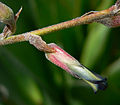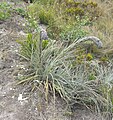Puya
| Puya subsp. var. | ||||||||||||||||||||||||||||||||||||||||||||||||||||||||
|---|---|---|---|---|---|---|---|---|---|---|---|---|---|---|---|---|---|---|---|---|---|---|---|---|---|---|---|---|---|---|---|---|---|---|---|---|---|---|---|---|---|---|---|---|---|---|---|---|---|---|---|---|---|---|---|---|

|
|
| ||||||||||||||||||||||||||||||||||||||||||||||||||||||
| ||||||||||||||||||||||||||||||||||||||||||||||||||||||||
| Standard Cyclopedia of Horticulture |
|---|
|
Puya (Chilean name). Bromeliaceae. Large terrestrial xerophytic South American bromeliads. Allied to Pitcairnia (differing in having a fully superior rather than partially superior ovary).—Forty-four species, according to Mez (DC. Monogr. Phaner. 9). For culture, see also Billbergia. Puya also includes the plants known in trade as Pourretia. Puyas and pitcairnias are generally found in collections of bromeliads and are usually grown in moist tropical houses. The native home of the puyas is on the steep stony slopes of the Cordilleras at high altitudes with little other vegetation for company except some species of cereus. This would indicate that drier and cooler conditions, or such as are given cacti and succulents, would suit them best, yet they thrive equally well in the tropical house. Indeed, the writer has found most of the family Bromeliaceae very accommodating not only to temperature and moisture conditions, but to soils and methods of growing them; for example many of the tillandsias may be grown on blocks of wood as epiphytes, yet they do equally well grown in pots. But what perhaps is more remarkable is the fact that several of the stronger-growing bromeliads appear to grow equally well either in a strong loamy mixture, or a mixture of chopped fern root and charcoal. The writer has pineapples growing in both mixtures with equal success. But the most rational treatment is to give all the bromeliads conditions and soil similar to the environment in which they are found in their native habitat, yet according to the experience of the writer few plants possess such remarkable adaptability to changed conditions as do these plants. (E.J. Canning.) P. spathacea, Mes (Pitcairnia spathacea, Griseb.). Lvs. up to 18 in. long and 1 in. broad, the spines incurved: panicle about 2 ft. long; sepals ovate, acuminate, pale rose; petals dull blue. Argentina. B.M. 7966.—P. violacea, Mes. Lvs. up to 20 in. long, linear, stiff, spiny in margin: panicle 15-20 in. long; sepals green, lanceolate, 1-1 1/4 in. long. acute; petals deep violet. Chile.
|
Puya is a genus of the botanical family Bromeliaceae, subfamily Pitcairnioideae. These terrestrial plants are native to the Andes Mountains of South America and southern Central America. Many of the species are monocarpic, with the parent plant dying after one flower and seed production event.
The species Puya raimondii is notable as the largest species of bromeliad known, reaching 3 m tall in vegetative growth with a flower spike 9-10 m tall. The other species are also large, with the flower spikes mostly reaching 1-4 m tall.
The name 'Puya' was derived from the Mapuche Indian (Chile) word meaning "point".
Cultivation
Propagation
Pests and diseases
Species
- Puya adscendens L.B. Smith
- Puya aequatorialis André
- var. albiflora André
- Puya alata L.B. Smith
- Puya alba L.B. Smith
- Puya alpestris (Poeppig) Gay
- Puya alpicola L.B. Smith
- Puya angelensis E. Gross & Rauh
- Puya angulonis L.B. Smith
- Puya angusta L.B. Smith
- Puya antioquiensis L.B. Smith & R.W. Read
- Puya araneosa L.B. Smith
- Puya argentea L.B. Smith
- Puya aristeguietae L.B. Smith
- Puya asplundii L.B. Smith
- Puya assurgens L.B. Smith
- Puya atra L.B. Smith
- Puya barkleyana L.B. Smith
- Puya bermejana Gómez, Slanis & Grau
- Puya berteroniana Mez
- Puya bicolor Mez
- Puya boliviensis Baker
- Puya boopiensis R. Vásquez, Ibisch & R. Lara
- Puya boyacana Cuatrecasas
- Puya brachystachya (Baker) Mez
- Puya brackeana Manzanares & W. Till
- Puya brittoniana Baker
- Puya cajasensis Manzanares & W. Till
- Puya cardenasii L.B. Smith
- Puya cardonae L.B. Smith
- Puya casmichensis L.B. Smith
- Puya castellanosii L.B. Smith
- Puya cerrateana L.B. Smith
- Puya chilensis Molina
- Puya claudiae Ibisch, R. Vásquez & E. Gross
- Puya clava-herculis Mez & Sodiro
- Puya cleefii L.B. Smith & R.W. Read
- Puya cochabambensis R. Vásquez & Ibisch
- Puya coerulea Lindley
- var. violacea (Brongniart) Smith
- var. monteroana (Smith & Looser) Smith & Looser
- var. intermedia (Smith & Looser) Smith & Looser
- Puya commixta L.B. Smith
- Puya compacta L.B. Smith
- Puya coriacea L.B. Smith
- Puya cristata L.B. Smith
- Puya cryptantha Cuatrecasas
- Puya ctenorhyncha L.B. Smith
- Puya cuatrecasasii L.B. Smith
- Puya cuevae Manzanares & W. Till
- Puya cylindrica Mez
- Puya dasylirioides Standley
- Puya densiflora Harms
- Puya depauperata L.B. Smith
- Puya dichroa L.B. Smith & R.W. Read
- Puya dodsonii Manzanares & W. Till
- Puya dolichostrobila Harms
- Puya dyckioides (Baker) Mez
- Puya elviragrossiae R. Vásquez & P.L. Ibisch
- Puya entre-riosensis Ibisch & E. Gross
- Puya erlenbachiana Ibisch & R. Vásquez
- Puya eryngioides André
- Puya exigua Mez
- Puya exuta L.B. Smith & R.W. Read
- Puya fastuosa Mez
- Puya ferox Mez
- Puya ferreyrae L.B. Smith
- Puya ferruginea (Ruiz & Pavón) L.B. Smith
- Puya fiebrigii Mez
- Puya floccosa (Linden) E. Morren
- var. compacta L.B. Smith
- Puya fosteriana L.B. Smith
- Puya fulgens L.B. Smith
- Puya furfuracea (Willdenow) L.B. Smith
- Puya gargantae L.B. Smith
- Puya gerd-muelleri W. Weber
- Puya gerdae W. Weber
- Puya gigas André
- Puya gilmartiniae G.S. Varadarajan & Flores
- Puya glabrescens L.B. Smith
- Puya glandulosa L.B. Smith
- Puya glareosa L.B. Smith
- Puya glaucovirens Mez
- Puya glomerifera Mez & Sodiro
- Puya goudotiana Mez
- Puya gracilis L.B. Smith
- Puya grafii Rauh
- Puya grandidens Mez
- Puya grantii L.B. Smith
- Puya grubbii L.B. Smith
- Puya gutteana W. Weber
- Puya hamata L.B. Smith
- Puya harmsii (Castellanos) Castellanos
- Puya herrerae Harms
- Puya herzogii Wittmack
- Puya hirtzii Manzanares & W. Till
- Puya hofstenii Mez
- Puya horrida L.B. Smith & R.W. Read
- Puya hortensis L.B. Smith
- Puya huancavelicae L.B. Smith
- Puya humilis Mez
- Puya hutchisonii L.B. Smith
- Puya ibischii R. Vásquez
- Puya iltisiana L.B. Smith
- Puya isabellina Mez
- Puya joergensenii H. Luther
- Puya killipii Cuatrecasas
- Puya kuntzeana Mez
- Puya laccata Mez
- Puya lanata Kunth
- Puya lanuginosa (Ruiz & Pavón) Schultes f.
- Puya larae R. Vásquez & Ibisch
- Puya lasiopoda L.B. Smith
- Puya laxa L.B. Smith
- Puya lehmanniana L.B. Smith
- Puya leptostachya L.B. Smith
- Puya lilloi Castellanos
- Puya lineata Mez
- Puya llatensis L.B. Smith
- Puya lokischmidtiae R. Vásquez & Ibisch
- Puya longisepala Mez
- Puya longispina Manzanares & W. Till
- Puya longistyla Mez
- Puya lopezii L.B. Smith
- Puya × loxensis Manzanares & W. Till
- Puya lutheri W. Till
- Puya macbridei L.B. Smith
- ssp. yungayensis W. Weber
- Puya macropoda L.B. Smith
- Puya macrura Mez
- Puya maculata L.B. Smith
- Puya mariae L.B. Smith
- Puya medica L.B. Smith
- Puya membranacea L.B. Smith
- Puya meziana Wittmack
- Puya micrantha Mez
- Puya mima L.B. Smith & R.W. Read
- Puya minima L.B. Smith
- Puya mirabilis (Mez) L.B. Smith
- Puya mitis Mez
- Puya mollis Baker
- Puya mucronata Manzanares
- Puya nana Wittmack
- Puya navarroana Manzanares & W. Till
- Puya nigrescens L.B. Smith
- Puya nitida Mez
- var. glabrior L.B. Smith & R.W. Read
- Puya nivalis Baker
- Puya nutans L.B. Smith
- Puya obconica L.B. Smith
- Puya occidentalis L.B. Smith
- Puya ochroleuca Betancur & Callejas
- Puya olivacea Wittmack
- Puya oxyantha Mez
- Puya pachyphylla R. Vásquez & Ibisch
- Puya parviflora L.B. Smith
- Puya pattersoniae Manzanares & W. Till
- Puya paupera Mez
- Puya pearcei (Baker) Mez
- Puya penduliflora L.B. Smith
- Puya × pichinchae Mez & Sodiro
- Puya pitcairnioides L.B. Smith
- Puya pizarroana R. Vásquez, Ibisch & St. Beck
- Puya ponderosa L.B. Smith
- Puya potosina L.B. Smith
- Puya pratensis L.B. Smith
- Puya prosanae Ibisch & E. Gross
- Puya pseudoeryngioides H. Luther
- Puya pygmaea L.B. Smith
- Puya pyramidata (Ruiz & Pavón) Schultes f.
- Puya quillotana W. Weber
- Puya raimondii Harms
- Puya ramonii L.B. Smith
- Puya ramosa L.B. Smith
- Puya rauhii L.B. Smith
- Puya reducta L.B. Smith
- Puya reflexiflora Mez
- Puya retrorsa Gilmartin
- Puya riparia L.B. Smith
- Puya robin-fosteri H. Luther
- Puya roezlii E. Morren
- Puya roldanii Betancur & Callejas
- Puya roseana L.B. Smith
- Puya rusbyi (Baker) Mez
- Puya sagasteguii L.B. Smith
- Puya sanctae-crucis (Baker) L.B. Smith
- Puya sanctae-martae L.B. Smith
- Puya santanderensis Cuatrecasas
- Puya santosii Cuatrecasas
- var. verdensis Cuatrecasas
- Puya secunda L.B. Smith
- Puya sehuencasensis R. Vásquez, Ibisch & R. Lara
- Puya silvae-baccae L.B. Smith & R.W. Read
- Puya simulans L.B. Smith
- Puya smithii Castellanos
- Puya sodiroana Mez
- Puya solomonii G.S. Varadarajan
- Puya spathacea (Grisebach) Mez
- Puya stenothyrsa (Baker) Mez
- Puya stipitata L.B. Smith
- Puya strobilantha Mez
- Puya textoragricolae W. Weber
- Puya thomasiana André
- Puya tillii Manzanares
- Puya tovariana L.B. Smith
- Puya trianae Baker
- var. amplior L.B. Smith & R.W. Read
- Puya tristis L.B. Smith
- Puya trollii L.B. Smith
- Puya tuberosa Mez
- Puya tunarensis Mez
- Puya ugentiana L.B. Smith
- Puya ultima L.B. Smith
- Puya valida L.B. Smith
- Puya vargasiana L.B. Smith
- Puya vasquezii Ibisch & E. Gross
- Puya venezuelana L.B. Smith
- Puya venusta Philippi
- Puya vestita André
- Puya volcanensis Castillon
- Puya weberbaueri Mez
- Puya weberiana E. Morren ex Mez
- Puya weddelliana (Baker) Mez
- Puya werneriana R.W. Read & L.B. Smith
- Puya westii L.B. Smith
- Puya wrightii L.B. Smith
- Puya wurdackii L.B. Smith
- Puya yakespala Castellanos
Gallery
If you have a photo of this plant, please upload it! Plus, there may be other photos available for you to add.
References
- Standard Cyclopedia of Horticulture, by L. H. Bailey, MacMillan Co., 1963

















